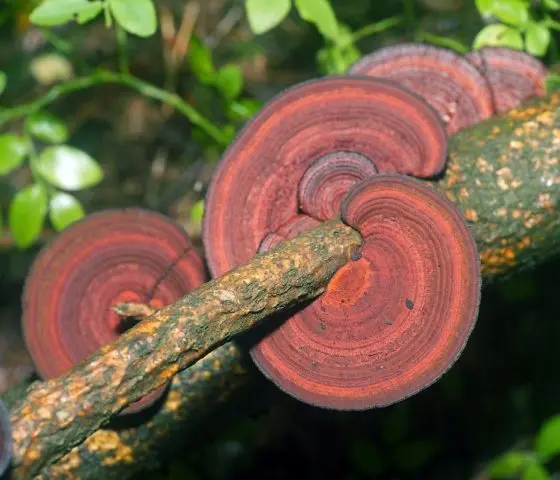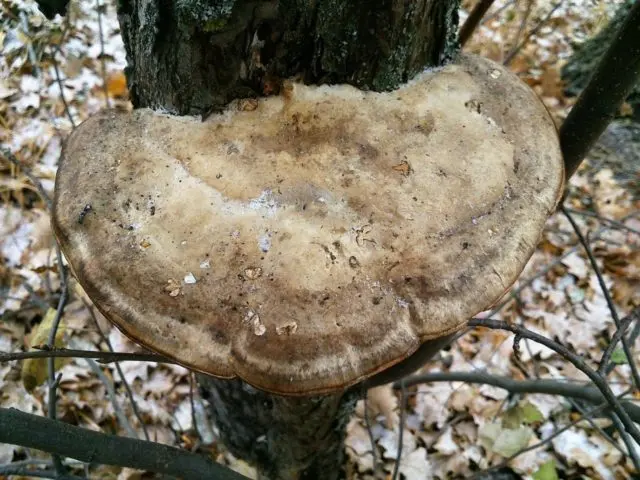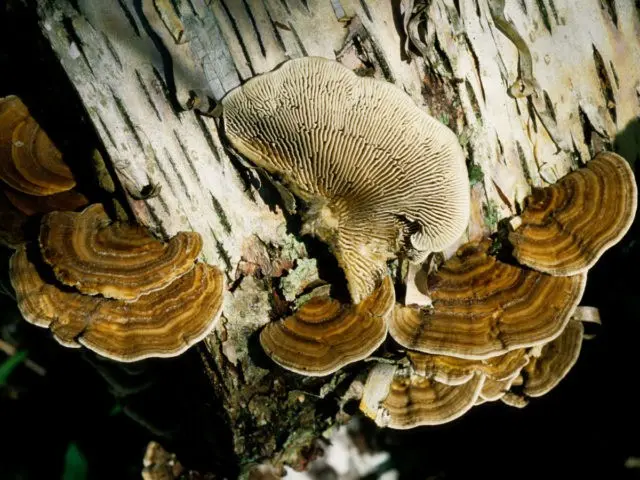Contents
Representative of the genus Dedaleopsis from the Polypore family. Dadaleopsis tricolor is known by several Latin names:
- Lenzites tricolor;
- Daedaleopsis tricolor;
- Daedaleopsis confragosa var. tricolor;
- Agaricus tricolor.

The color is bright, with maroon stripes located closer to the edge of the cap.
What does dadaleopsis tricolor look like?
One-year-old daedaleopsis tricolor grows in loose groups covering large areas on the surface of the wood.
External characteristic:
- fruiting bodies sessile and narrowed at the base with compaction in the form of a tubercle in the lower part;
- the surface of the cap is wrinkled with radial color zones, in young specimens the shade is closer to gray with a clearly defined light stripe along the edge;
- in the process of growing up, the color becomes tricolor: at the base – brown or dark gray with a purple tint, towards the edge – with alternating areas of purple or dark red, as well as brown;
- fruit bodies prostrate, rounded with wavy edges, thin;
- the surface is dry, slightly bumpy, bare;
- the hymenophore is lamellar, branched, the arrangement of the plates is rare, the color at the beginning of growth is beige or whitish, with time it becomes light brown with a reddish tint and a silvery sheen;
- with mechanical damage, the spore-bearing layer turns brown.
The flesh is light with a brown tint, without a pronounced odor.

Three-colored daedaleopsis growing on branches, completely covers the wood, growing together with its sides
Where and how to grow
The distribution area is in the zone of temperate and warm climate. It parasitizes on living wood, deadwood trunks, branches. In Siberia, it occurs on willow, aspen, birch, in the southern regions – more often on alder. An annual mushroom with the beginning of vegetation in May, lasting until November. Grows singly or in tiled scattered loose groups. Becomes the cause of the defeat of trees with white rot.
Is the mushroom edible or not?
The pulp of daedaleopsis tricolor is thin – within 3 mm. The structure is rigid both at the beginning and at the end of the growing season, therefore it is of no nutritional value. There is no information on toxicity.
Twins and their differences
Outwardly similar to daedaleopsis, the tricolor inedible tinder fungus is bumpy (rough). Fruit bodies are smaller, dense arrangement, often fused laterally. The caps are thicker, the color is uneven with radial indistinct color zones. The color is light brown, different shades of yellow. The edges at the beginning of growth are beige, in old mushrooms they are dark gray.

The life cycle of the tinder fungus is up to three years
Lenzites birch is an annual species, the most common in Our Country. Densely spaced fruiting bodies often coalesce to form rosettes. The surface is zonal, at the beginning of growth it is light, gray, cream. Over time, the colors darken, clear boundaries are defined. Inedible.

The surface of the cap in adult specimens is covered with a green coating.
Conclusion
Daedaleopsis tricolor is an annual species distributed in all climatic zones, the main accumulation is in Western Siberia. Fruiting bodies with a rigid structure are of no nutritional value. Symbiosis with hardwoods causes the spread of white rot on trees.









